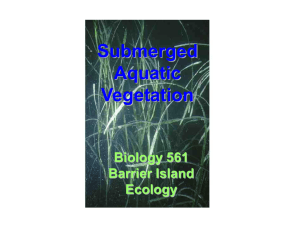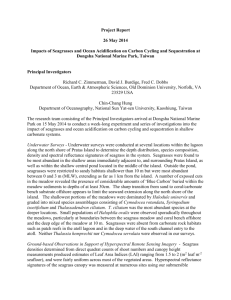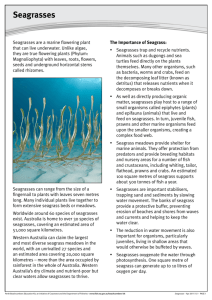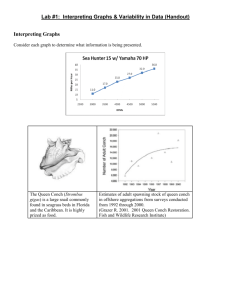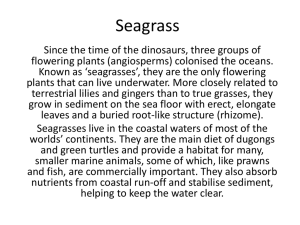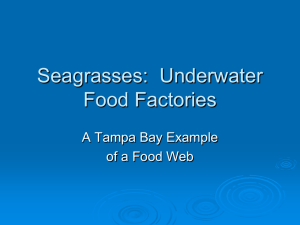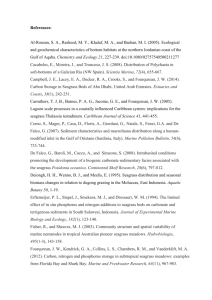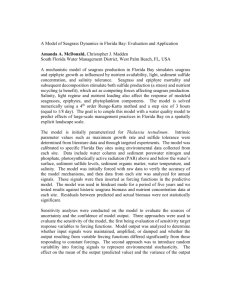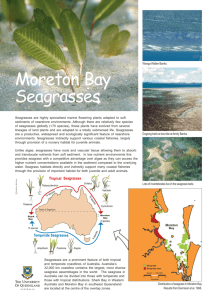Seagrasses
advertisement
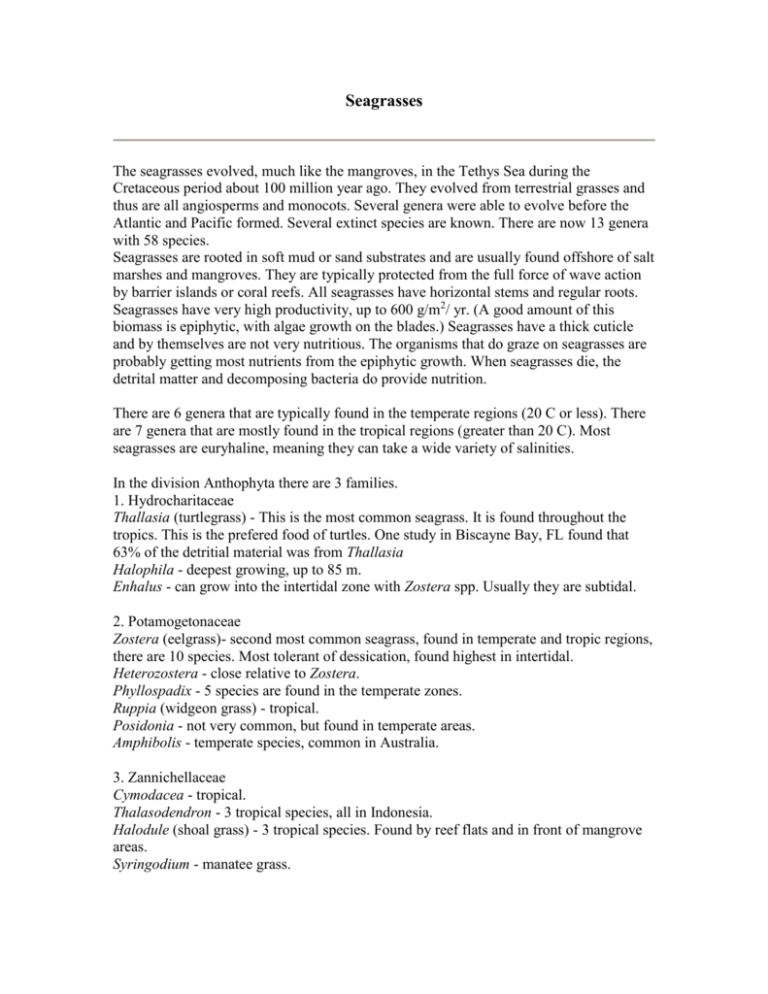
Seagrasses The seagrasses evolved, much like the mangroves, in the Tethys Sea during the Cretaceous period about 100 million year ago. They evolved from terrestrial grasses and thus are all angiosperms and monocots. Several genera were able to evolve before the Atlantic and Pacific formed. Several extinct species are known. There are now 13 genera with 58 species. Seagrasses are rooted in soft mud or sand substrates and are usually found offshore of salt marshes and mangroves. They are typically protected from the full force of wave action by barrier islands or coral reefs. All seagrasses have horizontal stems and regular roots. Seagrasses have very high productivity, up to 600 g/m2/ yr. (A good amount of this biomass is epiphytic, with algae growth on the blades.) Seagrasses have a thick cuticle and by themselves are not very nutritious. The organisms that do graze on seagrasses are probably getting most nutrients from the epiphytic growth. When seagrasses die, the detrital matter and decomposing bacteria do provide nutrition. There are 6 genera that are typically found in the temperate regions (20 C or less). There are 7 genera that are mostly found in the tropical regions (greater than 20 C). Most seagrasses are euryhaline, meaning they can take a wide variety of salinities. In the division Anthophyta there are 3 families. 1. Hydrocharitaceae Thallasia (turtlegrass) - This is the most common seagrass. It is found throughout the tropics. This is the prefered food of turtles. One study in Biscayne Bay, FL found that 63% of the detritial material was from Thallasia Halophila - deepest growing, up to 85 m. Enhalus - can grow into the intertidal zone with Zostera spp. Usually they are subtidal. 2. Potamogetonaceae Zostera (eelgrass)- second most common seagrass, found in temperate and tropic regions, there are 10 species. Most tolerant of dessication, found highest in intertidal. Heterozostera - close relative to Zostera. Phyllospadix - 5 species are found in the temperate zones. Ruppia (widgeon grass) - tropical. Posidonia - not very common, but found in temperate areas. Amphibolis - temperate species, common in Australia. 3. Zannichellaceae Cymodacea - tropical. Thalasodendron - 3 tropical species, all in Indonesia. Halodule (shoal grass) - 3 tropical species. Found by reef flats and in front of mangrove areas. Syringodium - manatee grass. Reproduction: Flowering plants: angiosperms: -some will live shallow enough to put a stalk out above the water with a flower on it. This will have wind blown pollination. -most release pollen into the water and allow it to get carried away by tides and current.Usually they have a timing mechanism to reproduce all at the same time -Monecious: only one sex on a plant at a time (male or female) -Diecious: both sexes on one plant -advantageous: fertilize self and no need to wait for pollination Zostera is an example of a seagrass that pollinates via the air. Probably related to tolerance to low tides and is found growing in areas with a lesser amount of water than usual. Seagrasses are found in 3 basic morphological shapes: simple blades, tubluar stem, and spoon or ovid shaped. Plants are linked together by rhizomes. The epiphythic growth occurs between sections of the plants as well. Ecology : Seagrass meadows are important for 1. Grazers - Manatees, turtles and ducks (widgeons) graze directly 2. Indirect grazers on epiphytes - fish, molluscs, echinoderms, crustaceans and others. 3. Detrital feeders - almost any feeders. 4. Shelter - fish, crustacea, echinoderms, also beds for predatory gastropods such as helmet shells, cones, and conchs looking for smaller molluscs. Echinoderms like sand dollars, sea biscuits, and big starfish are also found here. This is also a good nursery area for smaller fish because then the bigger fish come in to find them. Seagrass meadows can be monospecific or multi-generic. Common communities in the Gulf of Mexico are Thallasia, Halodule and Syringodium Common communities in the Gulf of California are Thallasia, Halodule, Ruppia and Zostera J. Torre looking at Zostera marrina beds in Gulf of California. Examining differences between northern and southern populations. Northern plants have smaller blades, reproduction is mostly by rhizomes in perennial stands. Seed germination seems to be triggered by salinity changes. But germination rates are low. Southern beds have larger blades, seed germination triggered by temperature increasing above 20. Germination success is high. In the US the major seagrass beds are in Florida, Chesapeake Bay, California and Texas -3,000,000 acres in Florida alone -1/3 Gulf Coast & Panhandle -1/3 Florida Bay & Keys -1/3 Atlantic Side: Biscayne & North A lot of seagrass are being lost 1. Sewage outfalls kill off seagrasses because of turbidity (shading) and extra nutrients create algal blooms (these either take over or cover up plants). 2. Dredging and dredge spoils. 3. Recreation: boats and jet skis destroy seagrass beds. 4. Thermal pollution - Turkey Point Nuclear Station on Biscayne Bay caused change from mixed Halodule - Thallasia beds to just Halodule 5. Pollutants and changes in flow from Everglades to Florida Bay. 6. Changes in grazer populations. Diseases in seagrass beds: 1931 - East coast, Zostera marina hit with wasting disease. 1932 - Wasting disease showed up in Europe. 1933 - 90-99% of this species gone, took decades for Zostera to recover. Slime mold thought to be cause. Thallasia die-off in late 1980's in Florida Bay, 4,000 ha completely killed, 23,000 ha severely affected. Also probably a slime mold. May have been induced by warming of waters (El Nino?) or changes in water inflow from Everglades Restoration and Revegetation Projects: It is important to reestablish seagrass beds because they are important nurseries for fisheries, they reduce erosion, and reduce nutrient pollution. There are several methods for revegetation: transplanting new beds - estimated costs are $2000/acre in 3 ft. of water, and $200,000/acre in 8 ft. of water. Non-anchoring methods include: 1) plugs: dig out seagrass with a shovel and replant it somewhere else. 2) cans with bottoms cut out: put plant in can and transplant cans. 3) direct seeding: take seeds directly from plant and plant the seeds in a good spot. 4) transplanting mats of material: try and pull up the whole mat and transplant it. Anchoring methods include: use of ties or rubber bands weaving into plastic or paper mesh (effective but expensive). Some human uses of seagrasses are as weaving material for dolls, mats, and baskets (especially Zostera and Thallasia by native Americans). The Misquito people of Nicaragua also ate the seeds of Thallasia. R. Felger observed the Seri Indians in the Gulf of California and wrote two papers on their practices. The first described how Zoestra was washed to the beach and then collected and used as a food source and weaving material for dolls, and baskets. The second discussed the indigenous practice of turtle hunting, which was passed on to the Mexican people . This sharing of knowledge quickly wiped out the turtle population living in seagrass beds as they overfished and overhunted.
